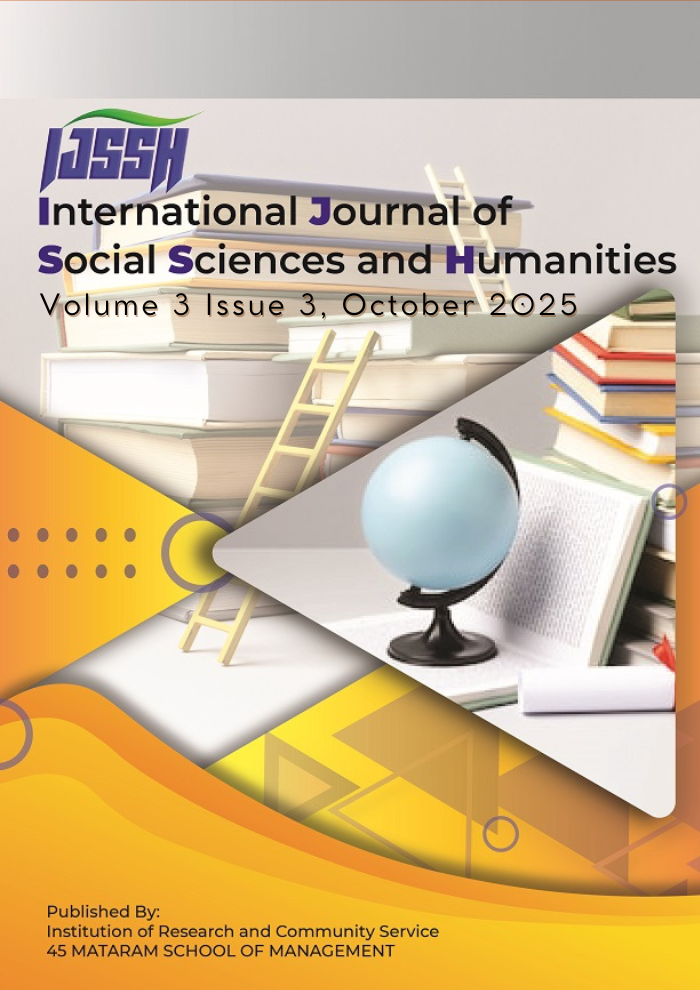Local Language as Social Capital: A Sociolinguistic Study in Building the Cohesion of a Multicultural Society
DOI:
https://doi.org/10.55681/ijssh.v3i3.1516Keywords:
Social capital, Social cohesion, Multicultural societyAbstract
Local languages are one of the important instruments in building social cohesion in a multicultural society. In Indonesia, regional language diversity not only functions as a means of communication, but also as social capital that strengthens social ties, collective identity, and solidarity between citizens. This study aims to analyze the role of local languages in building the cohesion of multicultural communities through a sociolinguistic perspective. The research was conducted with a qualitative approach through literature studies, text analysis, and comparative studies of several practices of using local languages in social interactions. The results of the study show that local language is a symbol of identity that strengthens a sense of belonging in a certain community as well as a means of identity negotiation in a multicultural context. On the other hand, local languages play a role in building social networks based on common beliefs and norms that strengthen social solidarity. However, challenges arise when local languages experience a decline in function due to the dominance of national and global languages. Therefore, the preservation of local languages through education, media, and cultural activities needs to be strengthened to maintain its role as social capital. This study emphasizes that local languages are not only cultural heritage, but also a strategic instrument to strengthen social cohesion in the midst of the plurality of Indonesian society.
References
Arka, I. W. (2013). Language management and minority language maintenance in Indonesia: Strategic issues. Language Documentation & Conservation, 7, 80–105. http://hdl.handle.net/10125/4568?
Bucholtz, M., & Hall, K. (2005). Identity and interaction: A sociocultural linguistic approach. Discourse studies, 7(4-5), 585-614. https://doi.org/10.1177/1461445605054407
Buti, F. N., & Neonbasu, G. (2022). Budaya Ha’aluha sebagai Sarana Kohesi Sosial Suku Kemak di Desa Sadi-Kabupaten Belu. Warta Governare: Jurnal Ilmu Pemerintahan, 3(1), 371-390.
Claridge, T. (2018). Social Capital and Digital Networks. Palgrave Macmillan.
Fannia, T., Johana, K., Awliya, F., Rismawaty, F., Ameri, M., & Lau, S. L. (2023). Intercultural Communication Interaction of Multicultural Society in West Kalimantan Province: Ethnographic Studies. KnE Social Sciences, 632-644. https://orcid.org/0009-0000-3400-3101
Luardini, M. A. (2016). Socio-Cultural Values of Traditional Communities: A Case Study of the Dayak in Kalimantan. Asian Culture and History, 8(2), 1-9. http://dx.doi.org/10.5539/ach.v8n2p1
Ibrahim, M. (2025). Bahasa dan Kelas Sosial: Hubungan Antara Pilihan Kata dan Status Sosial. Proceedings Series on Health & Medical Sciences, 7, 114-119. https://doi.org/10.30595/pshms.v7i.1456
Suraya, R. S., Marhadi, A., Akihary, W., Apituley, P. S., & Maruanaya, R. F. (2021). Local Language Maintenance Based on the Story of the Mekongga People in Kolaka District Southeast Sulawesi Province. LingLit Journal Scientific Journal for Linguistics and Literature, 2(3), 103-112. https://doi.org/10.33258/linglit.v2i3.510
Saud, M., Ibrahim, A., & Ashfaq, A. (2025). Youth revelation of social media on multiculturalism and cultural integration in Indonesia. Social Sciences & Humanities Open, 11, 101626. https://doi.org/10.1016/j.ssaho.2025.101626
Paauw, S. (2009). One land, one nation, one language: An analysis of Indonesia’s national language policy. In H. Lehnert-LeHouillier & A. B. Fine (Eds.), University of Rochester Working Papers in the Language Sciences, 5(1), pp. 2–16.
Putnam, R. D. (2015). Bowling alone: America’s declining social capital. In The city reader (pp. 188-196). Routledge. https://doi.org/10.4324/9781315748504-30.
Saharudin, S. (2014). Reflection on Social Cohesion of Sasak Speakers and the Trends Transformed. Makara Human Behavior Studies in Asia, 18(2), 140-148. https://doi.org/10.7454/mssh.v18i2.3468
Saepulmilah, et al. (2025). Pluralism and Multiculturalism in Indonesia. Electronic Journal of Education, Social Economic and Technology, 6(1), 1136–1147.
Omoniyi, T. (2004). The sociolinguistics of borderlands: Two nations, one community. Africa World Press.
Syam, C., Seli, S., & Abdu, W. J. (2023). Dynamics of Language Interaction in Multicultural Urban Communities: Analysis of Socio-Cultural Linguistic Environment. Society, 11(2), 575–588. https://doi.org/10.33019/society.v11i2.628
Setijadi, C. (2023). ‘We are people of the Islands’: translocal belonging among the ethnic Chinese of the Riau Islands. Asian Ethnicity, 24(1), 108-131. https://doi.org/10.1080/14631369.2022.2069082
Tokan, F. B. (2016). Modal sosial dalam tata kelola pembangunan. Gov Journal, UTA45 Jakarta.
Widyasari, L., Nurhadi, & Rahman, A. (2022). Modal sosial masyarakat kota Surakarta dalam menghadapi pandemi COVID-19. Muqoddima: Jurnal Ilmu Pemerintahan, 3(1), 16-35.
Downloads
Published
How to Cite
Issue
Section
License
Copyright (c) 2025 Gold Sunday Chukwuemeka, Muhammad Yamin

This work is licensed under a Creative Commons Attribution-NonCommercial-NoDerivatives 4.0 International License.







